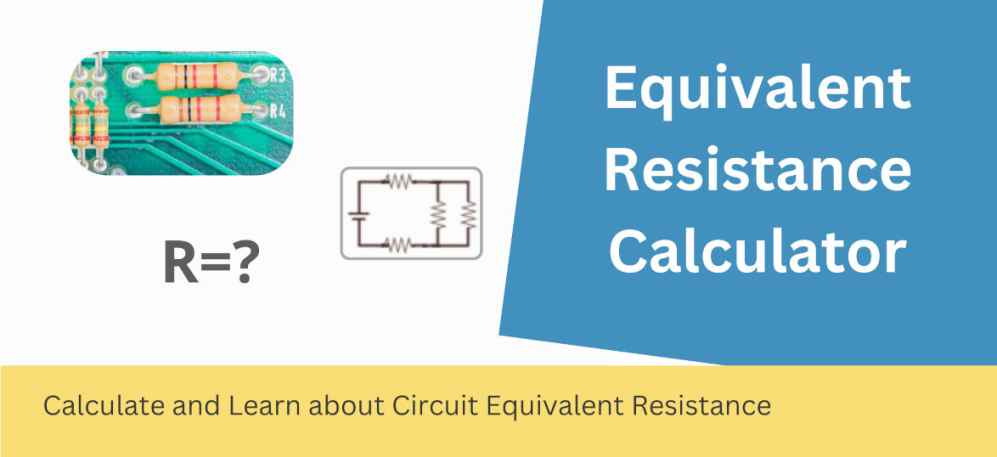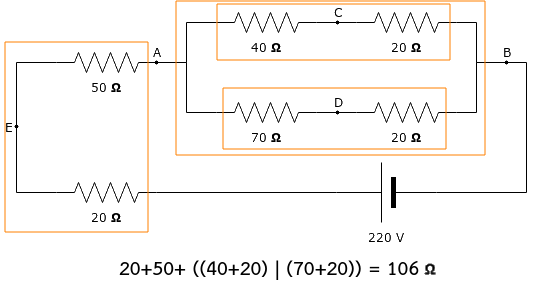
Home » Circuits » Circuit Equivalent Resistance Calculator
Finding difficulty in circuit resistance calculations? Here is the solution. This Online Equivalent resistance calculator makes easy the time taking process of multiple times calculating the resistance of series and parallel blocks in a single circuit. Find the equivalent resistance of a resistor circuit using this tool in an effortless way.
Enter resistor values as they were arranged in series, parallel, or in combination in the below text input field and click Submit.
like… 1 + (2 | 3) Means Resistor valued 1 is series with parallel resistors valued 2 and 3
Fill a, b, c resistor values >> Click any circuit image ‘Add’ >> Click on Calculate
Tip: a, b, c values can be given though below numeric keys
Watch below video tutorial for using the circuit resistance calculator.
Basic Circuit Text forms

Use bracket pair whenever needed. See Example circuits below.
This calculator is a must-have tool for students, professors and engineers who are working on electronic circuit-related projects. Also one can confirm or verify the calculated equivalent resistance value here. Our circuit equivalent resistance calculator can also be used as both the parallel resistor calculator and series resistor calculator.
Also see our Irregular 4-Side Object Area Calculator at fineducalcs.
Calculator Components Details
Series Parallel Combination Input Bar
The topmost input bar in the calculator can be inputted using the below given buttons or directly a series or parallel block inserted. Numeric values can be entered using keyboard.
Block Input Bar
The second input bar. Series or parallel values should be entered separating with space. The Resistors values inserted into combination bar (top) as a single block using its below buttons. Block directly inserted into position where cursor is there.
Calculator Usage
To insert nested blocks, give a extra space in the block input bar for a nested block. Place the cursor nested block position in combination bar, insert the block from block input bar. Repeat the process for multiple nested blocks.
Notations
Resistors & Notations In Series In Parallel A, B A + B A | B A, B, C, D A+B+C+D A | B | C | D In Combination Example A | B | ( C + D )
Example circuit and its Text form
Here are few series and parallel combination circuits, it will help in converting the circuit into Text form, which you are going to calculate resistance.

How to use Fineducalcs Circuit Equivalent Resistance Calculator to find the equivalent resistance
- Have the circuit with resistors that can be written in series and parallel combination. Otherwise, use Kirchhoff’s rules to calculate total resistance.
- Make sure all resistors resistance values are known.
- First identify all parallel type resistor arrangement and write them into text form.
- Add all series type resistor arrangement to the already written text form.
- Input the text form in the calculator and get circuit equivalent resistance instantly.
Resistance Calculation
Resistance Definition
It’s a property of substance to oppose the flow of electrical current through it. Specified in units of Ohms.
Equivalent Resistance Formulas
Equivalent resistance is a crucial concept in analyzing electrical circuits. It allows us to simplify complex networks and further electric calculations. Here are the formulas for calculating resistance of series and parallel circuits.
Series Circuits:
Imagine resistors acting like hurdles on a racetrack. In a series circuit, the current must overcome each hurdle one after another. Resistors are connected in a single loop. Naturally, the total resistance denoted by R(Eq), is simply the sum of individual resistances.
R(Eq) = R1 + R2 + R3 + …
This formula is aligns with Ohm’s Law (V = IR), stating that the voltage drop across a series circuit equals the sum of voltage drops across individual resistors. For instance, multiple lights in series offers higher resistance and dims the overall brightness compared to a single light.
Parallel Circuits:
Imagine multiple racetracks branching out. Current can flow through all paths simultaneously. The resistors are connected in separate branches. The equivalent resistance becomes smaller, calculated by the inverse of the sum of individual inverses.
R(Eq) = 1 / (1/R1 + 1/R2 + 1/R3 + …)
This formula aligns with Kirchhoff’s Current Law (I in = I out), stating that the total current entering a parallel junction equals the sum of currents flowing through each branch. For example, connecting LEDs in parallel allows more current to flow, thereby increasing their overall brightness. Results in different scenario than above series arrangement.
Practical Applications

Equivalent resistance plays an important role in the design of real-world electrical and electronics circuits, whether they are simple or complex. From the calculation of total resistance, we can calculate current flow, voltage drops, and power consumption. It will be crucial in various tasks like designing voltage dividers for powering delicate electronics, selecting resistors for LED brightness control, analyzing complex circuits, etc. in various fields. Like from audio systems to power grids.
Therefore, equivalent resistance formulas and the connection to fundamental laws encourage us to design and analyze electrical circuits effectively. It starts with simple LED lighting and evolves to complex power systems; thus, mastering this concept unlocks a world of possibilities in the knowledge and activity of this field, electricity.
This equivalent resistance calculator online will become integral in calculating advanced circuits resistance. Suggested to bookmark this free to use online calculator.